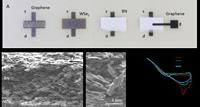
Jonathan Coleman
Trinity College Dublin, ireland
Title: All-printed electrochemical thin-film transistors from networks of liquid-exfoliated nanosheets
Biography
Biography: Jonathan Coleman
Abstract
With the advent of the Internet of Things, the development of printed electronics (PE) is becoming increasingly important, with much research focusing on developing new materials. A number of material sets have been studied, including organics, inorganic nanoparticles and nanotube/nanowire networks. High operating voltages (up to 50V), low mobility (<10 cm2/Vs) and poor current injection are still challenges for organic thin film transistors (OTFTs). Networks of inorganic nanoparticles or nanotubes have demonstrated mobilities and on:off ratios of >10 cm2/Vs and >106 respectively, but may face problems with scalability and integration. These problems have led a number of researchers in the field of 2D materials to attempt to produce printed transistors where the channel material is a network of semiconducting nanosheets. Because of the relatively high mobility of 2D materials, such a network might display mobilities which are competitive or even superior to those achievable with printed organics. In addition, one could envisage all-printed transistors consisting of interconnected networks of semiconducting, conducting and insulating 2D nanosheets. However, switchable nanosheet networks have not been demonstrated. Here, using electrolytic-gating, we demonstrate all-printed, vertically-stacked electrochemical transistors with graphene source, drain and gate electrodes, a transition metal dichalcogenide channel and a BN separator, all formed from nanosheet networks. The BN network contains an ionic liquid within its porous interior that allows electrolytic gating in a solid-like structure. Nanosheet network channels display on-off ratios of up to 600, transconductances exceeding 5 mS and mobilities of >0.1 centimeters squared per volt per second. The on-currents scaled with network thickness and volumetric capacitance as well as the network mobility. In contrast to other devices with comparable mobility, large capacitances, while hindering switching speeds, allow these devices to carry higher currents at relatively low drive voltages.to become trauma- informed that would help this recognition.


